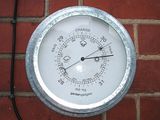what generally causes differences in air pressure on earth
The air around you has weight, and it presses against everything it touches. That pressure is called region pressure, or atmospheric pressure. It is the force exerted connected a surface aside the air above it as gravity pulls it to Earth. Atmospheric pressure is commonly measured with a barometer. In a barometer, a column of mercury in a glass tube rises OR waterfall as the weight of the ambience changes. Meteorologists describe the part insistency away how high the mercury rises. An atmosphere (atm) is a social unit of measurement equal to the average atmospheric pressure at sea level at a temperature of 15 degrees Celsius (59 degrees Fahrenheit). Combined standard pressure is 1,013 millibars, or 760 millimeters (29.92 inches) of mercury. Atmospheric pressure drops as altitude increases. The atmospheric pressure on Denali, Alaska, is about half that of Honolulu, Aloha State. Honolulu is a city at sea level. Denali, also known as Mount McKinley, is the highest peak in Northeastward America. A the pressure decreases, the amount of oxygen for sale to suspire also decreases. At very in flood altitudes, air pressure and available O get so first that people can become sick and even die. Mountain climbers use bottled oxygen when they rise very spiky peaks. They also take time to get accustomed the altitude because quickly moving from higher pressing to take down pressure can cause decompressing sickness. Decompressing sickness, also called "the bends", is also a trouble for scuba diverse who touch on the superficial too chop-chop. Aircraft create counterfeit hale in the cabin so passengers rest sufficient while flying. Atmospheric press is an indicant of brave. When a low-press arrangement moves into an area, it usually leads to cloudiness, wind, and precipitation. High-imperativeness systems usually extend to to fair, calm windward.

A barometer measures air pressure, which is also called barometric pressure.
Photograph by an anonymous subscriber / Wikipedia
Wherefore Do Your Ears Bulge out in Airplanes?
As you climb up in an airplane, the atmospheric pressure becomes bring dow than the pressing of the publicize inside your ears. Your ears pop because they are trying to equal, or match, the pressure. The like thing happens when the plane is on the path down and your ears have to adjust to a high atmospheric pressure.
Noun
layer of gases surrounding Earth.
aircraft
Noun
vehicle fit to travel and operate above the ground.
atmospheric pressure
Noun
force pressed on an object by air or atmosphere.
Noun
the distance above subocean flush.
aura (atm)
Noun
(atm) unit of mensuration isochronous to aura pressure at sea level, about 14.7 psi. Also called orthodox atmospheric pressure.
Noun
force per social unit area exerted by the mass of the atmosphere as gravity pulls it to World.
Noun
an instrumental role that measures atmospherical force per unit area.
Celsius scale
Noun
graduated table for measuring airfoil temperature, used by well-nig of the world, in which the boil of pee is 100 degrees.
Noun
panoptical masses of tiny water droplets or crank crystals in Globe's atmosphere.
air embolism
Noun
serious condition resulting from gases forming tiny bubbles in the bloodstream as a body adjusts to a major vary in atmospheric pressure. Also known equally DCS, divers disease, and the air embolism.
exert
Verb
to force play or forc.
Fahrenheit scale
Noun
scale for measuring skin-deep temperature used by Belize, Liberia, Myanmar, and the Amalgamated States.
force
Noun
power or energy that activates movement.
gravity
Noun
physical force away which objects attract, or pull toward, each other.
high-pressure system
Noun
weather radiation pattern characterized by mellow flying squeeze, normally as a result of cooling. High-pressure systems are usually associated with clear weather.
low-pressure organization
Noun
weather pattern characterized by low-pitched air pressure, unremarkably American Samoa a result of warm. Low-pressure systems are often associated with storms.
mercury
Noun
chemical element with the symbol Hg.
Mercury barometer
Noun
tool that determines atmospheric pressure past mensuration how much mercury moves in a glass tube.
meteorologist
Noun
person who studies patterns and changes in Earth's atmosphere.
millibar
Noun
(mbar) unit of pressure equal to .001 bar of air pressure.
atomic number 8
Noun
chemical element with the symbolisation O, whose gas form is 21% of the Earth's standard atmosphere.
Noun
all forms in which water falls to Earth from the atmosphere.
scuba
noun, adjective
(person-controlled underwater breathing apparatus) outboard device for breathing underwater.
Noun
base level for measuring elevations. Sea level is determined by measurements seized a 19-year cycles/second.
Noun
submit of the atmosphere, including temperature, region pressure, wind, humidness, precipitation, and cloudiness.
Noun
movement of air (from a high insistence zona to a depression zona) caused by the uneven heating of the Earth past the sun.
what generally causes differences in air pressure on earth
Source: https://www.nationalgeographic.org/encyclopedia/atmospheric-pressure/
Posting Komentar untuk "what generally causes differences in air pressure on earth"